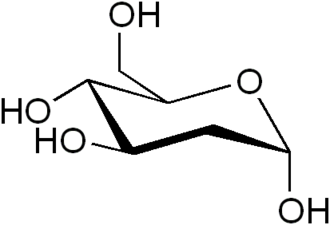2-Deoxy-D-glucose
Overview of 2-Deoxy-D-glucose
2-Deoxy-D-glucose[edit]

2-Deoxy-D-glucose (2-DG) is a glucose molecule that has been modified by the removal of an oxygen atom from the second carbon. This alteration prevents it from undergoing further glycolysis, making it a useful tool in biochemical research and a potential therapeutic agent.
Chemical Properties[edit]
2-Deoxy-D-glucose is a glucose analog that differs from normal glucose by the absence of a hydroxyl group at the C-2 position. This structural change is crucial as it inhibits the molecule's ability to proceed through the glycolytic pathway.
Mechanism of Action[edit]
2-DG is taken up by cells via the same transporters as glucose. Once inside the cell, it is phosphorylated by hexokinase to form 2-deoxy-D-glucose-6-phosphate. However, this compound cannot be further metabolized by phosphoglucose isomerase, leading to an accumulation of 2-DG-6-phosphate and a subsequent decrease in glycolysis and ATP production.
Applications in Research[edit]
2-Deoxy-D-glucose is widely used in metabolic studies to investigate the role of glycolysis in various cellular processes. It is also employed in cancer research to study the Warburg effect, where cancer cells preferentially utilize glycolysis for energy production even in the presence of oxygen.
Therapeutic Potential[edit]
The ability of 2-DG to inhibit glycolysis has led to its investigation as a potential anticancer agent. By targeting the altered metabolic pathways in cancer cells, 2-DG may selectively inhibit tumor growth while sparing normal cells.
Safety and Side Effects[edit]
While 2-DG shows promise in preclinical studies, its use in humans is associated with potential side effects such as hypoglycemia and gastrointestinal discomfort. Further research is needed to fully understand its safety profile and therapeutic window.
Related Pages[edit]
Ad. Transform your life with W8MD's Budget GLP-1 injections from $75


W8MD offers a medical weight loss program to lose weight in Philadelphia. Our physician-supervised medical weight loss provides:
- Weight loss injections in NYC (generic and brand names):
- Zepbound / Mounjaro, Wegovy / Ozempic, Saxenda
- Most insurances accepted or discounted self-pay rates. We will obtain insurance prior authorizations if needed.
- Generic GLP1 weight loss injections from $75 for the starting dose.
- Also offer prescription weight loss medications including Phentermine, Qsymia, Diethylpropion, Contrave etc.
NYC weight loss doctor appointmentsNYC weight loss doctor appointments
Start your NYC weight loss journey today at our NYC medical weight loss and Philadelphia medical weight loss clinics.
- Call 718-946-5500 to lose weight in NYC or for medical weight loss in Philadelphia 215-676-2334.
- Tags:NYC medical weight loss, Philadelphia lose weight Zepbound NYC, Budget GLP1 weight loss injections, Wegovy Philadelphia, Wegovy NYC, Philadelphia medical weight loss, Brookly weight loss and Wegovy NYC
|
WikiMD's Wellness Encyclopedia |
| Let Food Be Thy Medicine Medicine Thy Food - Hippocrates |
Medical Disclaimer: WikiMD is not a substitute for professional medical advice. The information on WikiMD is provided as an information resource only, may be incorrect, outdated or misleading, and is not to be used or relied on for any diagnostic or treatment purposes. Please consult your health care provider before making any healthcare decisions or for guidance about a specific medical condition. WikiMD expressly disclaims responsibility, and shall have no liability, for any damages, loss, injury, or liability whatsoever suffered as a result of your reliance on the information contained in this site. By visiting this site you agree to the foregoing terms and conditions, which may from time to time be changed or supplemented by WikiMD. If you do not agree to the foregoing terms and conditions, you should not enter or use this site. See full disclaimer.
Credits:Most images are courtesy of Wikimedia commons, and templates, categories Wikipedia, licensed under CC BY SA or similar.
Translate this page: - East Asian
中文,
日本,
한국어,
South Asian
हिन्दी,
தமிழ்,
తెలుగు,
Urdu,
ಕನ್ನಡ,
Southeast Asian
Indonesian,
Vietnamese,
Thai,
မြန်မာဘာသာ,
বাংলা
European
español,
Deutsch,
français,
Greek,
português do Brasil,
polski,
română,
русский,
Nederlands,
norsk,
svenska,
suomi,
Italian
Middle Eastern & African
عربى,
Turkish,
Persian,
Hebrew,
Afrikaans,
isiZulu,
Kiswahili,
Other
Bulgarian,
Hungarian,
Czech,
Swedish,
മലയാളം,
मराठी,
ਪੰਜਾਬੀ,
ગુજરાતી,
Portuguese,
Ukrainian